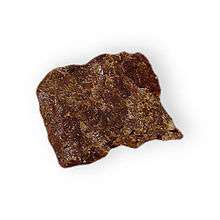Tephroite
Tephroite is the manganese endmember of the olivine group of nesosilicate minerals with the formula Mn2SiO4. A solid solution series exists between tephroite and its analogues, the group endmembers fayalite and forsterite. Divalent iron or magnesium may readily replace manganese in the olivine crystal structure.
| Tephroite | |
|---|---|
 Tephroite from Japan | |
| General | |
| Category | Silicate mineral |
| Formula (repeating unit) | Mn2SiO4 |
| Crystal system | Orthorhombic |
| Crystal class | Dipyramidal (mmm) H-M symbol: (2/m 2/m 2/m) |
| Unit cell | a = 4.88(2) Å, b = 10.61(2) Å c = 6.24(2) Å; Z = 4 |
| Identification | |
| Color | Olive-green, bluish green, gray, °esh-red, reddish brown; pale green in thin section, may be colorless |
| Crystal habit | Crystals typically short, prismatic, to 4 cm, or anhedral, equidimensional. Commonly in disseminated grains, compact, or massive. |
| Twinning | Uncommon on {011} |
| Cleavage | {010}, distinct; {001}, imperfect |
| Fracture | Uneven to conchoidal |
| Tenacity | Brittle |
| Mohs scale hardness | 6 |
| Luster | Vitreous to greasy |
| Streak | Pale gray |
| Diaphaneity | Transparent to translucent |
| Specific gravity | 3.87 – 4.12 |
| Optical properties | Biaxial (-) |
| Refractive index | nα = 1.759 nβ = 1.797 nγ = 1.860 |
| Birefringence | δ = 0.101 |
| Pleochroism | Weak; X = brownish red; Y = reddish; Z = greenish blue. |
| 2V angle | Measured: 60° to 70°, Calculated: 78° |
| References | [1][2][3] |
It was first described for an occurrence at the Sterling Hill Mine and Franklin, New Jersey, United States.[2] It occurs in iron-manganese ore deposits and their related skarns. It also occurs in metamorphosed manganese-rich sediments. It occurs in association with: zincite, willemite, franklinite, rhodonite, jacobsite, diopside, gageite, bustamite, manganocalcite, glaucochroite, calcite, banalsite and alleghanyite.[1] It can also be found in England and Sweden.
Tephroite has a hardness of 6 and a specific gravity of approximately 4.1, which is heavy for non-metallic minerals. Its name comes from the Greek tephros, "ash gray", for its color.[3] It can also be found olive-green, greenish-blue, pink, or brown. Other names for tephroite include mangan olivine and mangan peridot.
References
- http://rruff.geo.arizona.edu/doclib/hom/tephroite.pdf Handbook of Mineralogy
- http://www.mindat.org/min-3913.html Mindat.org
- http://webmineral.com/data/Tephroite.shtml Webmineral data